The plants that lay eggs : an extraordinary curiosity in the vegetable kingdom. They are living Mesozoic fossils. Similar to ferns, palms or conifers, they have separate sexes. They look like palms but are not. They produce big ovules similar to fruits. They grow very slowly and can change sex. The rarest plant in the world.
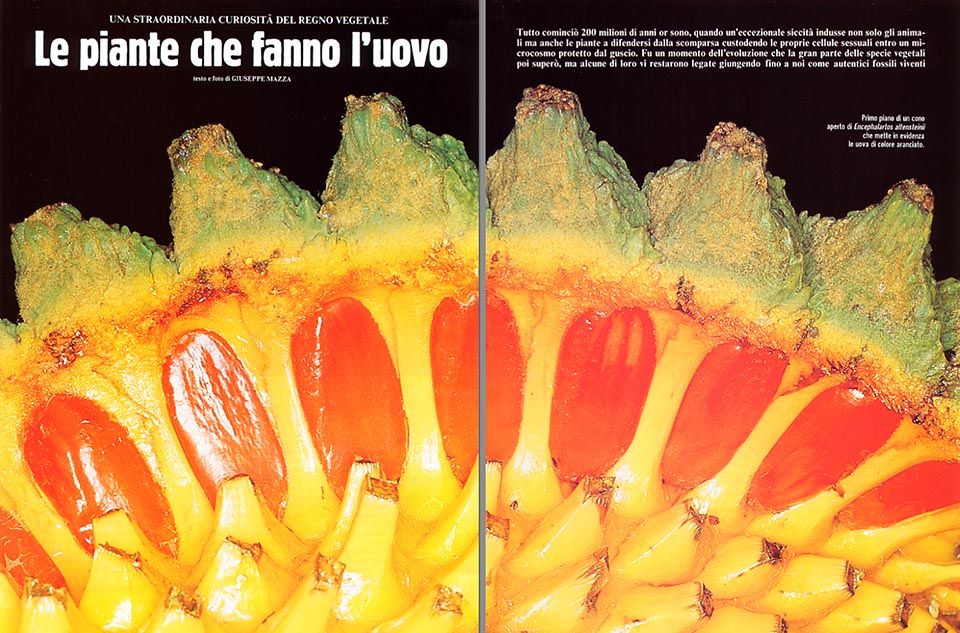
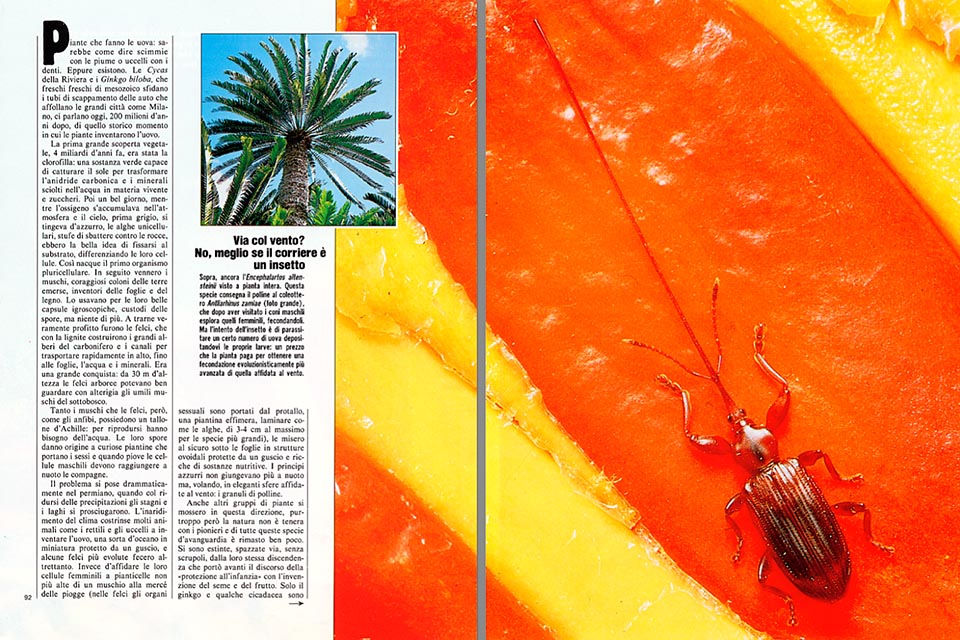
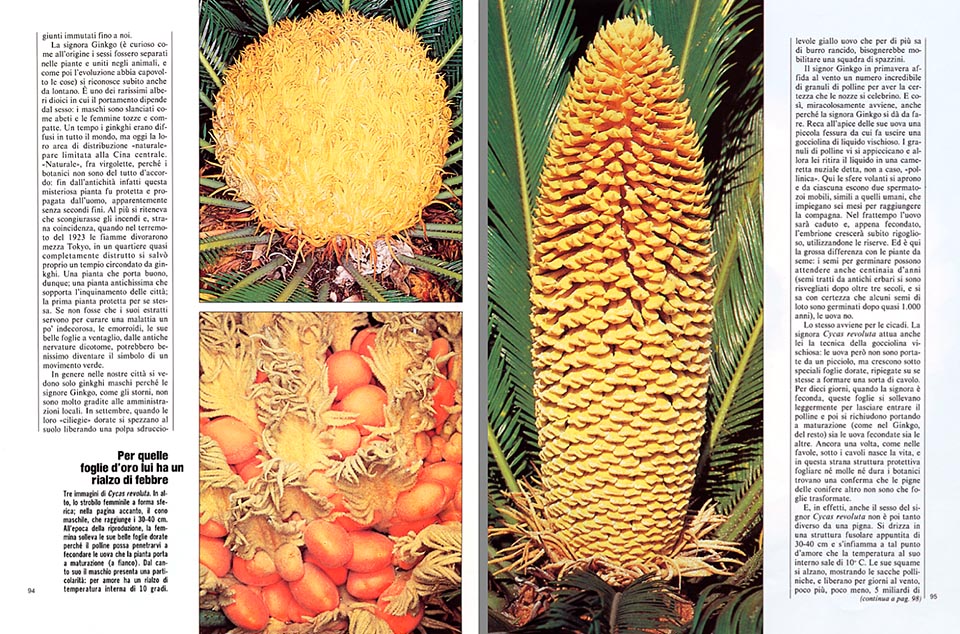
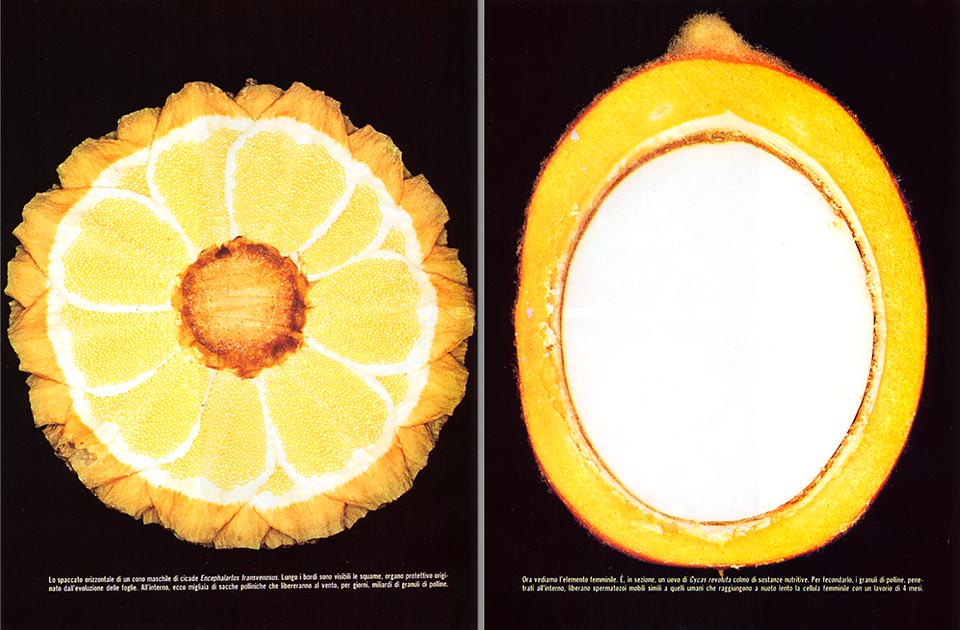
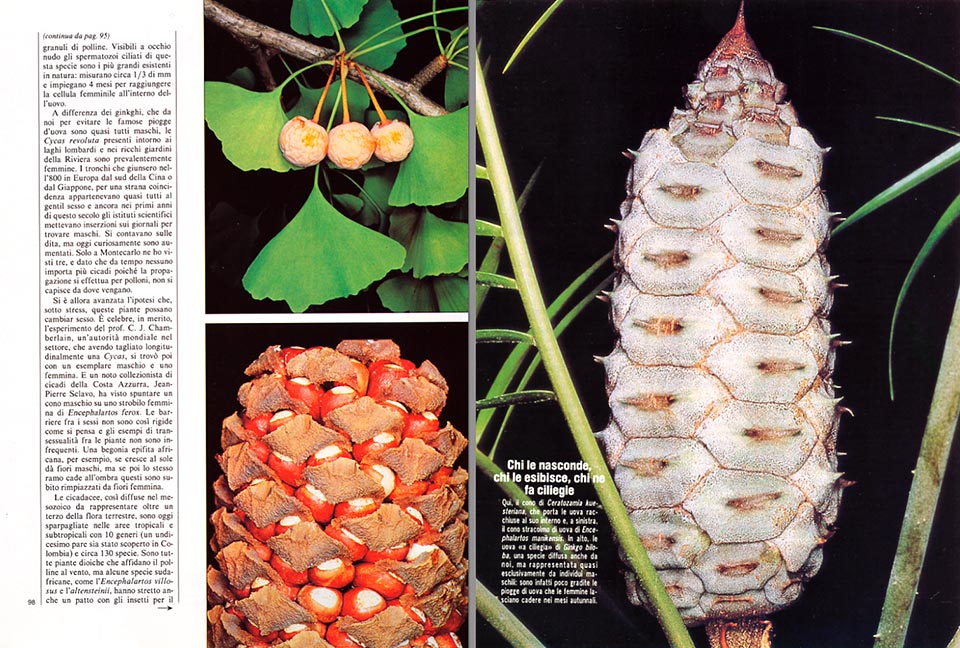
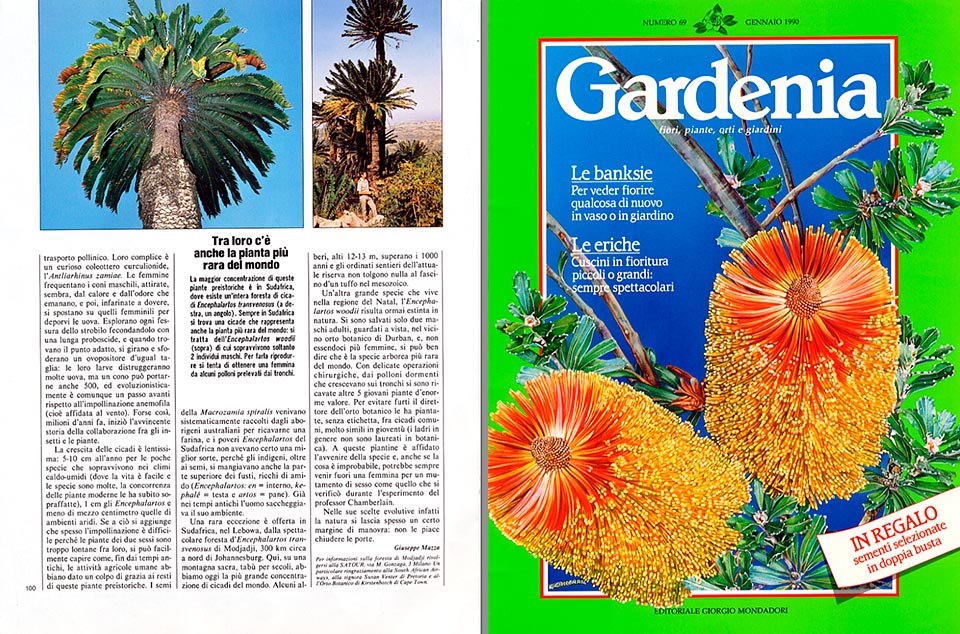
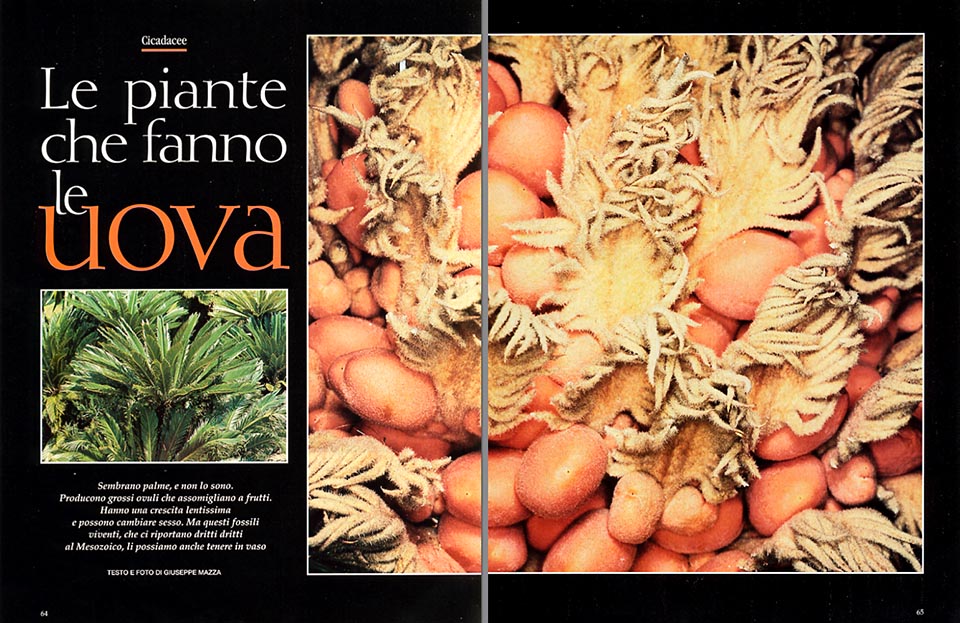
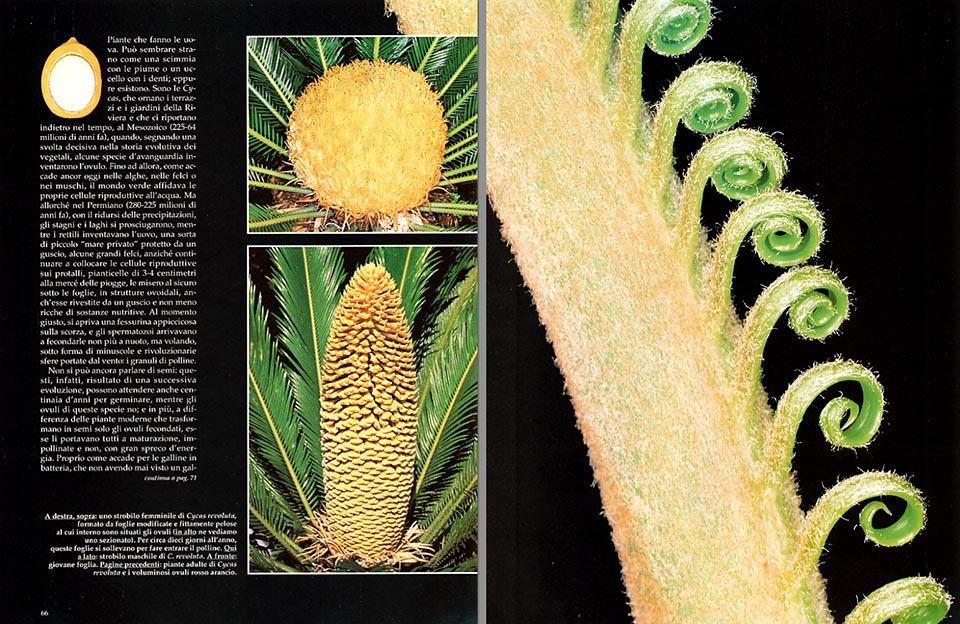
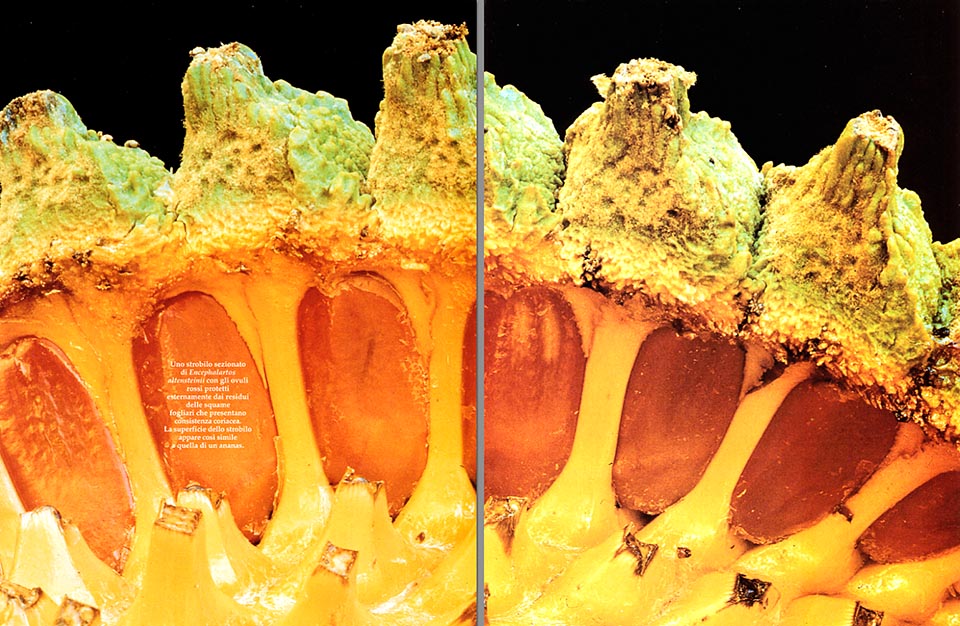
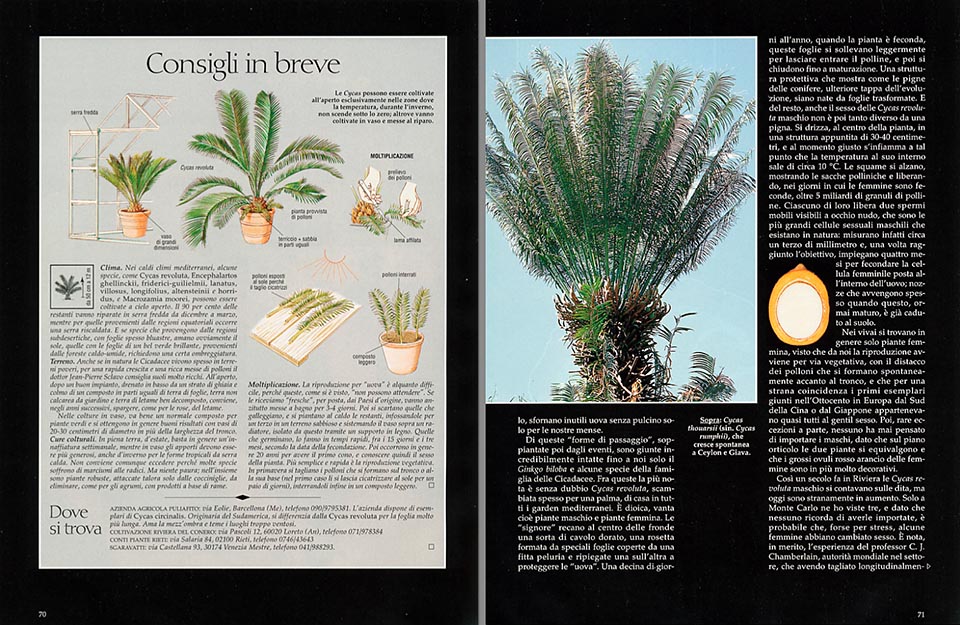
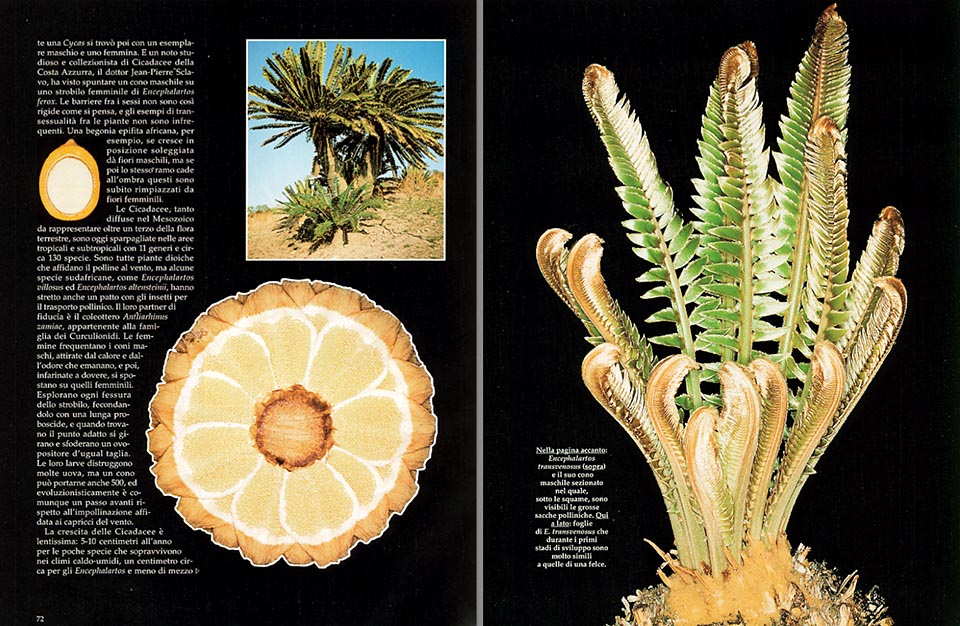
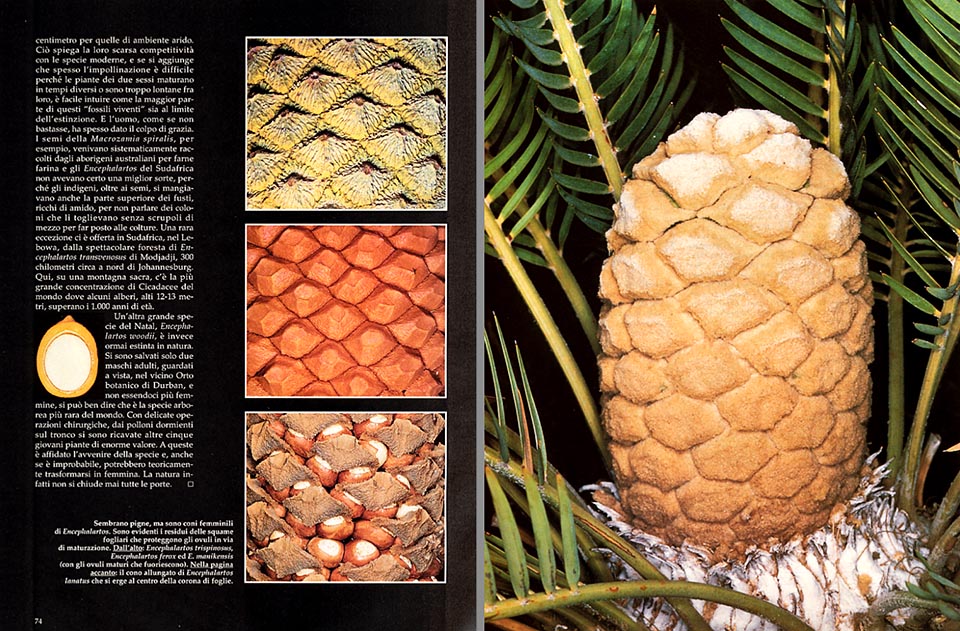

Texto © Giuseppe Mazza

English translation by Mario Beltramini
Plants which lay eggs. It would be like saying a monkey with feathers, or a bird with teeth. And yet, they exist.
The Cycas of the Riviera and the Ginkgo biloba which, coming straight from the Mesozoic, defy the exhausts of Corso Buenos Aires, in Milan, are talking to us, 200 millions of years later, about that historical moment when the plants invented the egg.
The first great vegetable discovery, 4 billions of years ago, had been the chlorophyll: a green substance capable to catch the sun in order to transform the carbon dioxide and the minerals dissolved in the water into living matter and sugars.
Then, a nice day, while the oxygen accumulated in the atmosphere and the sky, earlier grey, was becoming blue, the unicellular algae, tired of knocking against the rocks, had the nice idea to settle on the substratum, differentiating their cells.
It was the first pluri-cellular organism. Later on came the mosses, brave settlers of the emerged lands, inventors of the leaves and the wood. They used them for their nice hygroscopic capsules, keepers of the spores, but nothing else.
The ferns were those who indeed took advantage, as with the lignite, they built the great trees of the Carboniferous and the ducts for carrying up, rapidly, till the leaves the water and the minerals.
It was a major conquest and from an altitude of 30 metres, the arboreal ferns could look, with disdain, the humble mosses of the under wood.
And these last ones were objecting, we have invented the lignite, and, after all, who has conquered the mainland? And where were you when our ancestors, risking to die for dehydration, were leaving the ocean for hours, under the sun, during the low tide?
But the humble origins are quickly forgotten, and the big ferns, their nice leaves, similar to birds feathers, waving with the wind, did not care at all to reply.
However, both mosses and ferns, like the amphibians, have an Achille’s heel: they need water for reproducing. Their spores originate some odd small plants which carry the sexes, and when it’s raining the masculine cells must reach the feminine ones by swimming. Difficult task, romantic return to the algae and their coupling dances in the sea, but, no water, no marriage.
The problem arose dramatically in the Permian, when, with the reduction of the precipitations, ponds and lakes dried up. And this change of climate obliged many animals, like reptiles and birds, to invent the egg, a sort of small ocean protected by a shell, and some more evolved ferns did the same thing.
Instead of entrusting their feminine cells to small plants not taller than a moss, at the mercy of the rain (in the ferns the sexual organs are carried by the prothallium, an ephemeral small plant, laminar as the algae, of 3-4 cm at the maximum, for the largest species), did put them in safe under the leaves in ovoid structures protected by a shell and rich of nourishing substances. The Princes Charming did not come any more by swimming, but flying, in elegant spheres entrusted to the wind: the granules of pollen.
Also other groups of plants moved in this direction, but, unluckily, nature is not tender with pioneers, and vary little has remained of all these forerunner species. They died out, swept away, without any scruple, by their own offspring which carried ahead the matter of the “infancy protection”, with the invention of the seed and of the fruit.
Only the Ginkgo and some Cycadaceae have reached, unchanged, our times.
Mrs. Ginkgo, (it’s odd how, at the origin, the sexes were separated in the plants and united in the animals, and how, later on, the evolution has turned the things upside down), can be recognized from far away. It’s one of the very few dioicous trees where the appearance depends on the sex: males are slender like the fir trees, and the females are short and compact.
Formerly, ginkgoes were spread all over the world, but nowadays their “natural” distribution area seems to be limited to central China. Natural, in quotes, as botanists are not all of the same idea: since the old times, in fact, this enigmatic plant was protected and disseminated by the men, seemingly without ulterior motives. At the most, it was believed that it would avoid fires, and, odd coincidence, when, due to the earthquake of 1923, the blazes burnt half Tokyo, in a quarter almost completely destroyed, only a temple was preserved, and, indeed, same was surrounded by ginkgoes.
Consequently, a plant which brings good luck, a very old plant which endures the pollution of the cities; the first plant protected by itself. Should we ignore its extracts useful for treating a rather indecorous sickness, the piles, its beautiful and “graphic” fan-shaped leaves, with their ancient dichotomous nervures, could well become the symbol of an ecological movement.
In Milan, and normally in all our cities, we can see only male ginkgoes, because the ladies, like the starlings, are not much appreciated by local administrators.
In September, when their nice golden “cherries” break on the ground, releasing a yellow egg like slippery pulp, which is even stinking of rancid butter, they should be compelled to mobilize teams of street-sweepers.
And, furthermore, the Ladies Ginkgo do not hold any common sense: they do not limit themselves to grow up, like modern plants, only the fecundated ovules, but, like hens, also the eggs which have not been “honoured” by their partner.
In springtime, Mr. Ginkgo entrusts the wind with an incredible amount of granules of pollen. Unlike most of the flower plants, who, knowing the proverbial efficiency of mail services, prefer to use the “pony-express”, or the “couriers” (read “insects”, and “birds”), it has never betrayed the public service.
“Sending thousands of them”, it repeats, convinced, since the Jurassic, “even the shabbiest mail service will be finally able to deliver my granules”.
And, miraculously, this happens, also because Mrs. Ginkgo is active. It carries, on the apex of its eggs, a small opening, from where, when she desires (oh, yes!), drops out a small drip of a sticky liquid substance. The granules of pollen stick there, and then it withdraws the liquid in a nuptial cell, called, not by chance, “pollinic”. Here, the flying spheres open and from each one come out two mobile spermatozoa, similar to ours, which employ six months to reach the mate. During this time, the egg will fall down, and as soon as fecundated, the embryo will grow up, immediately lush, using its reserves.
And here stays the huge difference with the seed plants: while the seeds, to germinate, can wait even for hundreds of years (seeds, pulled out from old herbaria, have woken up after more than three centuries, and we know by sure that some seeds of lotus have germinated after almost 1.000 years), the eggs don’t do this.
Same thing happens for the cycads. Mrs. Cycas revoluta, whose remote relationship with some arboreal ferns seems likely (similar appearance and growing leaves rolled up on the apex), also applies the technique of the viscous small drop.
In this case, the eggs are not carried by a petiole, but grow under special golden leaves, folded on themselves, thus forming a sort of cabbage. For ten days, during which the lady is fertile, these ones rise gently to allow the pollen to get in, and then, close, bringing to ripening, like the Ginkgo, both the fecundated eggs and the others.
Once again, as in the tales, life comes out from under the cabbages, and, evolutionally, in this old leafy protective structure, neither soft, nor hard, botanists find a confirmation that the pine-cones of the conifers are nothing else than transformed leaves.
And, besides, also the sex of Mr. Cycas revoluta does not differ too much from a pine-cone. It rises in a sharp and straight structure of 30-40 cm, and gets so much excited (yes!), that its internal temperature increases of 10 °C. Its squamae get up, showing the pollinic bags, and release, for days, to the winds, more or less 5 billions of granules of pollen.
Visible to naked eye, the ciliated spermatozoa of this species are among the largest in nature: they measure about 1/3 of mm. and take about four months to reach the feminine cell inside the egg. Also here, the true and real fecundation often happens later on, on the ground.
Unlike ginkgoes, which in our countries, in order to avoid the famous rainfalls of eggs, are almost all male, the Cycas revoluta which adorn the Lombard lakes and the luxuriant gardens of the Riviera, are mainly feminine. The trunks which came in south Europe in 1800 from China or Japan, belonged, for an odd coincidence, to the gentle sex, and even at the beginning of this century, the scientific institutes were advertising in the newspapers, looking for males. They could be counted one one’s fingers, but nowadays they have, strangely, increased.
Only in Monte Carlo, I have seen, inexplicably, many of them, and seen that since some time nobody is importing cycads any more, because the reproduction happens by shoots, and that, for horticultural purposes, a male is equal to a female, nobody understands where they are coming from.
It has been then formulated the supposition that, under stress, these plants can change sex. It’s famous, about this, the test done by Prof. C.J. Chamberlain, a worldwide authority in this sector, who, having cut longitudinally a Cycad, got later a male specimen specimen, as well as a female one.
And a well known cycas collector of the Côte d’Azur, Jean Pierre Sclavo, has seen coming out a male cone on a feminine strobile of Encephalartos ferox.
The barriers between sexes are not so much rigid as commonly believed, and examples of trans-sexuality between plants are not uncommon.
An African epiphyte begonia, for instance, if growing under the sun, gives only male flowers, but if the same branch falls down in the shade, these ones are immediately replaced by feminine flowers.
And the spores of the horsetails, just to remain in the primitive plants, can produce masculine or feminine prothallia, depending on the ground where they fall on.
The Cycadaceae, so much widespread in the Mesozoic, to represent more than a third of the world flora, are nowadays scattered in the tropical and subtropical areas with 10 genera (an eleventh seems to have been discovered in Colombia), and about 130 species.
They are all dioicous plant which entrust the pollen to the wind, but some South African species, such as the Encephalartos villosus and the Encephalartos altensteinii, have made an alliance with the insects for the transportation of their pollen.
Their partner is a funny weevil, the Antliarhinus zamiae. The females frequent the masculine cones, attracted, it seems, by the warmth and the scent they exhale, and then, well powdered, move to the feminine ones, to lay the eggs. They explore every fissure of the strobile, fecundating it with a long trunk, and when they find the right place, they turn over and draw out an ovipositor of the same size. Their larvae will destroy many eggs, but a cone can carry even 500 of them, and evolutionally it’s in any case a step ahead from the anemophilous (non botanists to read “entrusted to the wind”), pollination. Perhaps in this way, millions of years ago, began the fascinating history of the collaboration between insects and plants.
The growth of cycads is very slow: 5-10 cm per year for the few species which survive in hot-humid climates (where the life is easy and the species are numerous, the competition of modern plants has immediately overwhelmed them), 1 cm, for the Encephalartos, and less than 1/2 cm for those living in dry habitats.
If to the above we add the fact that the pollination is frequently difficult, because the plants of the two sexes are too far from each other, it can be easily understood how, since the old times, the human agricultural activities have given the finishing stroke to the remains of these pre-historical plants.
The seeds of the Macrozamia spiralis, were systematically picked up by the Australian aborigines, to get a flour, and the unfortunate Encephalartos of South Africa, had not, by sure, a better fate, as natives, in addition to the seeds, ate also the upper parts of the stems, rich of starch (Encephalartos comes from EN = inner, KEPHALE = head, and ARTOS = bread). Even before modern times, man has always squandered his habitat.
A rare exception is offered, in South Africa, in Lebowa, by the spectacular forest of Encephalartos transvenosus of Modjadji, about 300 km north of Johannesburg. Here, on a holy mountain, guarded for centuries by the Queen of the rains, we have nowadays the largest concentration of cycads in the world. Some trees, 12-13 m. tall, are more than 1.000 years old, and the tidy paths of the present reserve do not spoil at all the fascination of a plunge into the Mesozoic.
Another huge species of Natal, the Encephalartos woodii, turns out to be, at this point, extinct in nature. Only two adult male specimen survive, closely watched, in the near botanical orchard of Durban, and as no more females do exist, we can rightly say that this is the most rare arboreal species in the world.
With delicate surgical operations, from the sleeping shoots which grew on the trunks, they have obtained further five young plants of enormous value. In order to avoid pilferages, the director of the Garden has planted them, without any label, between the common cycads, very similar when young (thieves, normally, do not hold any degree in botany). To these small plants is entrusted the future of the species, and, even if the thing is unlikely, as happened to Mr. Chamberlain, a female might, in case, come out.
In its evolutional choices, nature often leaves a margin of manoeuvre, and never shuts all the doors.
NATURA OGGI + GARDENIA – 1988
→ To appreciate the biodiversity within the CYCADACEAE family please click here.
→ To appreciate the biodiversity within the ZAMIACEAE family please click here.
